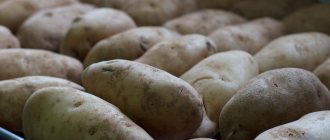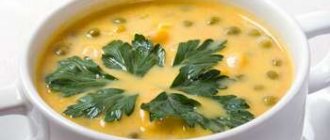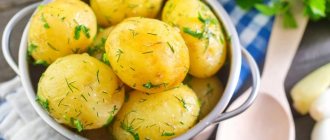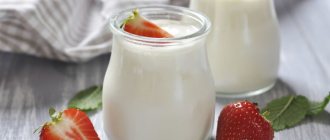Onion is a herbaceous plant of the onion family, one of the most important vegetable crops, widely used in cooking, folk medicine, and cosmetology. Onions have been cultivated for more than five thousand years, and nowadays they are used in the cuisines of all peoples of the world due to their unique taste. That is why it is important to know the calorie content of onions. Raw, dried, boiled, fried, pickled onions are added to soups, salads, sauces, vegetable stews, meat and fish dishes, used as a seasoning for canning and as a component of spicy mixtures.
Eating onions improves appetite, activates the secretion of gastric juice, accelerates digestion and absorption of food, and normalizes water-salt balance. Onion is a good diuretic, antiseptic, anthelmintic, anti-inflammatory, anti-sclerotic and anti-diabetic agent. Considering all these qualities, it is especially recommended to consume onions in winter.
Onions are divided according to the level of essential oils - sweet, semi-sharp, spicy and bitter; recently, mildly spicy, non-spicy, sweet delicacy and salad onions have appeared. It is noteworthy that the sweetest-tasting onion varieties contain the least amount of sugar, since the characteristic bitter taste of onions is given by essential oils, and their amount directly depends on the sugar content in the onion. This means that sweeter varieties of onions have less calories.
100 g of onion contains 40-43 kcal calories:
- Water – 86 g;
- Protein – 1.7 g;
- Carbohydrates – 10.5-11.0 g;
- Fiber – 0.8 g.
Calorie content, BJU and glycemic index of onions per 100 g
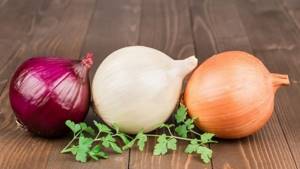
Fresh vegetables have a low glycemic index (GI), it does not provoke a sharp rise in blood sugar, and therefore is not contraindicated for people with diabetes. The energy value of the product and GI vary depending on the method of its preparation:
| Method of preparation and type of onion | Calorie content | Proteins, g | Fats, g | Carbohydrates, g | GI |
| fresh | 42 kcal | 1,1 | 0,1 | 9 | 10 |
| boiled | 42 kcal | 1,36 | 0,19 | 8,75 | 15 |
| fried | 258 kcal | 3,2 | 14 | 31 | 98 |
| stew | 48.5 kcal | 1.35 | 0.05 | 7.9 | 15 |
| baked | 36.6 kcal | 1,3 | 1,78 | 8,4 | 15 |
| green onions | 32 kcal | 1,8 | 0,2 | 7 | 39 |
| leek | 61 kcal | 1,5 | 0,3 | 14 | 15 |
| shallot | 72 kcal | 2,5 | 0,1 | 17 | 32 |
| onion | 41 kcal | 1,4 | 0,2 | 8,2 | 10 |
It is worth keeping in mind that when adding salt to onions, its calorie content increases by 2-3 kcal. Other additives, spices, sauces, oils, etc. also play a role. In the same way, the glycemic index changes when cooked - for example, caramelizing onions in sugar will significantly increase the GI.
Is there a difference in calories between red and white onions?
It cannot be said that it is the color of the bulbs that affects its nutritional value. Also, the number of calories depends on the content of proteins, fats and carbohydrates in the vegetable. The calorie content of classic onions is 42 kcal, and sweet varieties - 32-35 kcal. Any onion can be sweet, regardless of color.
Vitamin content
Table 1
| Vitamins | Content | Daily norm |
| C (ascorbic acid) | 10 mg | 14.29 % |
| E (α-, β-, γ-tocopherols) | 0.2 mg | 2 % |
| B1 (thiamine) | 0.05 mg | 3.33 % |
| B2 (riboflavin) | 0.02 mg | 1.11 % |
| B3 (PP) (nicotinamide) | 0.5 mg | 2.63 % |
| B4 (choline) | 6.1 mg | 1.22 % |
| B6 (pyridoxine) | 0.12 mcg | 6 % |
| B9 (folacin) | 9 mcg | 4.5 % |
Onions contain vitamins with high, medium and low levels, if we consider them according to the approved standards for the significance of the nutritional value of the product.
At the highest level of importance of the food value chain is vitamin C, which takes part in the body’s redox processes, improves body tone, and strengthens the immune system.
Vitamin B6 is at a medium level of importance and is involved in the metabolism of lipids and amino acids.
Vitamins of low content include:
- E, keeps the muscular system in good shape.
- B1, required to normalize the nervous and muscular systems.
- B2, maintains body tone.
- PP, participates in the formation of hemoglobin.
- B4, is involved in the biosynthesis of heme and proteins, cell proliferation, and tissue respiration.
- B9, supports the hematopoietic and digestive system.
Which cooking method has onions the most and least calories?

The largest number of calories (349 kcal per 100 g) contains dehydrated (dried) onions, which are flakes.
Reference. This product is produced on an industrial scale using drying machines. All the water, which makes up 90% of the mass of the raw onion, evaporates from the vegetable.
Baked onions contain the least calories. That is why people on diets prepare it this way. To prevent the calorie content from increasing, it is not recommended to add sauces or oil to the vegetable.
Benefits and harms
Onions are useful in any form. After heat treatment, it contains slightly less vitamins, but the same amount of mineral components. Let's consider the benefits and possible harm of raw and cooked products.
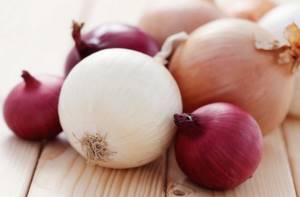
Raw onions
Of course, onions that have not undergone heat treatment are the most useful, because they contain more useful substances.
- Its use brings the following benefits:
- suppresses pathogenic microflora (viruses, bacteria);
- increases the body's defenses;
- improves metabolic processes;
- has an anthelmintic effect;
- stimulates appetite and promotes digestion;
- has a positive effect on the genitourinary area;
- removes harmful cholesterol;
- has a good effect on the functioning of the pancreas;
- can be used as an expectorant;
- is the prevention of diseases of the cardiovascular system.
The raw version irritates the mucous membranes and has more contraindications, which will be listed in the section of the same name below.
Did you know? The ancient Egyptians consumed onions as food, and a lot of this vegetable was eaten by the builders of the pyramids. The ancient Greek historian Herodotus noted that on the pyramid of Cheops there was an inscription that 1600 talents of silver were spent on buying onions, garlic and radishes for them.
Boiled onions
During cooking, a small part of the vitamins is destroyed and the product has almost the same beneficial properties as without processing. At the same time, boiled onions are a dietary product because they do not have such an irritating effect on the mucous membranes as raw ones. It has a much less pungent taste and can be used in baby food and consumed by breastfeeding women. It is not contraindicated for pancreatitis and other gastrointestinal diseases.
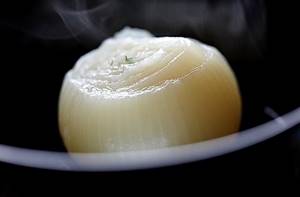
For diseases of the pancreas, it is even useful to include it in the diet. But in case of exacerbations of gastrointestinal diseases and some severe forms of stomach disease (erosive or atrophic gastritis), onions should be avoided in any form. If you have a stomach ulcer, you can consume a very small amount. It should be excluded in case of individual intolerance and allergies. Excessive use of this product may cause flatulence and abdominal pain.
Features of use
It is worth noting that regular consumption of onions has a positive effect on the entire body, it strengthens the immune system and gives vitality.
Important! If you have problems with digestion, it is better to hold off on introducing the raw product, as it irritates the gastrointestinal mucous membranes.
For men
Constant consumption of onions by males increases potency, enhances libido, and has a good effect on the quality of semen. This product is also an excellent prevention against prostate adenoma. This vegetable is often included in the diet for many diseases, as it has an anti-inflammatory effect, is a diuretic and prevents the appearance of tumor formations.
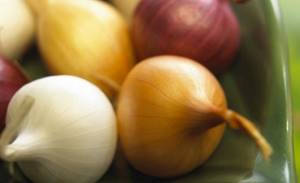
This product not only inhibits the appearance and development of adenoma, but also improves overall well-being by enhancing the immune system. Onion peels are good for certain symptoms of benign prostatic hyperplasia (BPH). A decoction of it reduces pain when taken regularly. At the same time, take a freshly prepared decoction. Moreover, the best results are obtained by mixing onions with honey or other bee products.
Find out in more detail what the benefits of onions are for the male body.
For women
Onions are recommended to be included in the menu for women who want to conceive a child, since this product contains enough zinc, which helps normalize reproductive function. The vegetable also contains a lot of iron, so it must be consumed when hemoglobin is low. This product is relevant in the diet of pregnant and lactating women (boiled), since it contains vitamin B9, which is required for the normal development of the fetus.
The vitamins and antioxidants contained in this vegetable contribute not only to better health, but also to a better appearance and promote weight loss. Women use this vegetable for cosmetic purposes. You can make a face mask from it at home. To do this, use the product or its juice in raw form or in combination with other products. Onion juice without additives smoothes and brightens the skin and is an excellent remedy for skin pigmentation.

This product perfectly promotes hair strengthening and growth, helps with hair loss and fights dandruff. A decoction of onion peels gives the hair a golden hue, and also nourishes the hair and makes it shiny. The only drawback is that when used for cosmetic purposes, this vegetable gives off a specific smell. But after a while it still dissipates, so for the sake of getting a good result, you can ignore it.
Did you know? Onions contain more sugar than apples and pears. Pieces of this vegetable contain about 6% sugar. Therefore, when it is fried, when the substances that make it caustic break down, the vegetable acquires a sweetish taste.
For children
Nutritionists recommend including this vegetable in children's diets. It improves appetite and the digestive process, strengthens bones and blood vessels. This product is simply a storehouse of vitamins for a child’s body; it contains vitamins C and E, which are necessary at this age. Onion juice with warm milk helps children fall asleep soundly, and all dishes using raw vegetables are an excellent preventive measure against worms without side effects.

However, children should be introduced to this vegetable by first giving them a boiled product. Boiled vegetables can be given to babies from 8 months. It is usually given in pureed vegetable soups. It goes well with potatoes, pumpkin, zucchini, and carrots. You can add a small amount to your baby’s first puree soup – a quarter of a small onion. The raw product can be introduced into a child’s diet no earlier than three years of age. It is best added to salads.
Contraindications for the human body
- There are contraindications for consuming this product raw:
- pancreatitis;
- gastrointestinal ulcers, gastritis;
- individual intolerance;
- increased nervous excitability;
- for exacerbations of kidney, heart and liver diseases.
This product should be taken with caution during pregnancy and lactation.
In asthmatics, in its raw form it can cause an attack. There may be an allergic reaction or individual intolerance to it. You will be interested to learn about the rules for harvesting and storing onions.
Helpful cooking tips
There are the following recommendations for using onions:
- To prevent the peeled and cut head of the vegetable from drying out, it should be placed cut side down on a saucer with salt. You can also store it in an airtight container in the refrigerator. You can also grease the cut area with fat - this will also keep the onion fresh.
- To prevent this vegetable from causing tears due to its pungency, you need to cut it by putting your hands with the onion in a container with cool water.
- If you process onions near the stove that is on, your eyes will not water. You can also rinse the knife with cold water to get rid of watery eyes.
- Frozen vegetables should not be brought into a warm place to avoid spoilage. This product should be used immediately for food. Before use, it must be immersed in cold water for 3 hours, then its taste will not change.
- To prevent your hands from smelling after working with such a product, you can wipe them with salt, a weak solution of vinegar or coffee grounds, and then wash them with warm water and soap. To prevent the knife from smelling like onions, you also need to wipe it with salt.
- For slicing, it is better to use a plastic board, as it does not absorb onion juice as much as wood.
- To prepare the soup, the vegetable is finely chopped or fried. Don't throw the whole head into the soup. For frying, the onion is also cut into cubes, not rings.
- You can color the broth with a decoction of onion peels. In addition, this will make the soup more nutritious and healthy.
- If you took a vegetable for a salad, then you can remove the bitterness from it by placing it in a colander and pouring boiling water over it. To reduce bitterness, the chopped vegetable is washed in cool water.
- If you lightly sprinkle the onion with powdered sugar when frying, it will taste better and acquire a beautiful golden crust.
- To ensure that the chopped vegetable does not burn during frying and has a pleasant appearance, it can be dipped in flour the day before the process.
- When stewing, this product is laid out in a layer of no more than 4 cm.
- To prepare salads, it is better to take sweet varieties of this vegetable.
- When marinated, it is used for salads, as a side dish for cold fish, especially herring, and also for cold meat.

Raw onions have a lot of beneficial properties and are very healthy, but they are not a dietary food. For many gastrointestinal problems, children and nursing women should consume a boiled product, which contains slightly less useful substances, but is not as irritating to the mucous membranes.
Boiled, stewed, baked onions - how many calories are in your favorite dishes?
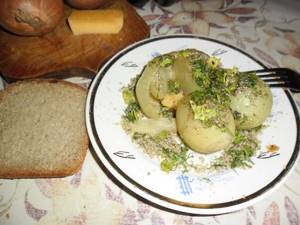
Everyone knows that “onions are a friend to health.” But won't he become the enemy of harmony? After all, very often the spicy vegetable is fried in oil and added to quite nutritious dishes. Of course, the large number of calories in fried onions does not inspire optimism. But when you pour yourself a bowl of soup with fried onions, you are unlikely to get a 100-gram portion of fried onions with the first course. Therefore, this vegetable cannot harm the figure in any way.
What is the calorie content of other dishes prepared using onions? What to use for the diet menu? See for yourself:
- baked and boiled onions – 36 kcal each;
- onion soup with beef broth (with the addition of cheese, butter, flour, potatoes) – 76 kcal;
- dietary onion soup with chicken broth (with olive oil, flour and dry white wine) – 55 kcal;
- pancakes with onions – 220 kcal;
- pie with onions and cabbage – 173 kcal;
- omelette with onions and champignons – 205 kcal.
The most valuable from the point of view of dietary abilities is the bitter vegetable in its natural form. This is a traditional addition to meat and sausage products; it goes well with cottage cheese, cheese, and is often used to make sandwiches. You can eat fresh onions simply with a piece of fresh bread. This is an excellent spicy-vitamin snack.
During heat treatment, it practically does not lose its beneficial elements, but its calorie content becomes even lower.
Video
We invite you to watch a short video that details the beneficial properties of onions. You will find out who it is recommended for regular use and what it can cure.
It is very convenient when creating a menu to take into account the number of calories of each product, because in this way you can get rid of grueling weight loss diets and not feel hungry. You will be interested to know what the calorie content of buckwheat is and why it is so popular in many diets.
- The calorie content of pears is low; the fruit is recommended for consumption by almost all people. But you shouldn’t overeat, because pears cause heaviness in the stomach.
- The calorie content of rice is low, it depends on the variety. When choosing rice, it is better to give preference to unpolished varieties.
- All fans of red vegetables need to know the calorie content of tomatoes and their benefits in order to eat vegetable salads more often.
Share in the comments how often do you keep track of your calories consumed, how does such monitoring help you improve your health and regulate your weight?
- Author: Maria Sukhorukikh
Rate this article:
- 5
- 4
- 3
- 2
- 1
(0 votes, average: 0 out of 5)
Share with your friends!
Bulb onions
Onions are a herbaceous perennial of the Onion family, one of the most common vegetable crops. Mediterranean countries, China and Iran used onions for food long before our era; in Russia, the spread of onions began in the 12th century from the Roman Empire.
Onions, depending on the variety, have a round, slightly elongated or flattened scaly bulb, white, purple or golden in color, the outer shell is dry and brittle, inside there are fleshy, juicy scales of white or slightly pinkish color. Onions have a pungent taste and a rather pungent odor.
Why count calories in onions?

People “cultivated” onions more than 3 thousand years ago. Presumably, it was first grown in Central Asia. The therapeutic properties of this vegetable were discovered almost immediately. And to this day they are actively used in folk medicine.
Onions occupy no less honorable place in cooking. Today it is included in almost all first courses and salads. Not only the tuber is used, but also the green part of this plant. Without onions, soup is not soup, borscht is not a joy, and the sauce is tasteless. This is why it is so important to know how many calories are in onions. Should you include this absolutely healthy product in your diet if you want to lose weight?

